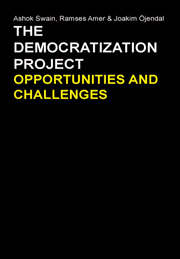Book contents
- Frontmatter
- Contents
- List of Tables
- List of Figures
- Acknowledgements
- Contributors
- The Democratization Project: Opportunities and Challenges
- 1 The Democratization Project: Peace, Conflict and Development
- 2 Non-Authorized Military Interventions and Legitimization by the United Nations
- 3 From Condemnation to Legitimization of Outcome: The United Nations and the Use of Force in Inter-State Relations
- 4 Demos or Deus: Patterns of Religious Dimensions in Asian Armed Conflicts, 1945–2005
- 5 The Left and Democratic Consolidation – Deepening Democracy in Latin America?
- 6 Democracy without People? – The Risk of Monopolizing the Democratization Project
- 7 The Role of Hamas in Building Palestinian Democracy in the Midst of Violence
- 8 Elections and Violence in Sri Lanka: Understanding Variation Across Three Parliamentary Elections
- 9 Post-Accord Elections and Armed Conflict
- 10 Peace Through Democracy? The Challenges of Postwar Democratization in Weak and War-Torn States
8 - Elections and Violence in Sri Lanka: Understanding Variation Across Three Parliamentary Elections
Published online by Cambridge University Press: 05 March 2012
- Frontmatter
- Contents
- List of Tables
- List of Figures
- Acknowledgements
- Contributors
- The Democratization Project: Opportunities and Challenges
- 1 The Democratization Project: Peace, Conflict and Development
- 2 Non-Authorized Military Interventions and Legitimization by the United Nations
- 3 From Condemnation to Legitimization of Outcome: The United Nations and the Use of Force in Inter-State Relations
- 4 Demos or Deus: Patterns of Religious Dimensions in Asian Armed Conflicts, 1945–2005
- 5 The Left and Democratic Consolidation – Deepening Democracy in Latin America?
- 6 Democracy without People? – The Risk of Monopolizing the Democratization Project
- 7 The Role of Hamas in Building Palestinian Democracy in the Midst of Violence
- 8 Elections and Violence in Sri Lanka: Understanding Variation Across Three Parliamentary Elections
- 9 Post-Accord Elections and Armed Conflict
- 10 Peace Through Democracy? The Challenges of Postwar Democratization in Weak and War-Torn States
Summary
Introduction
Democracy has a bloody history in many countries. In Kenya, several hundred people were killed in the aftermath of the December 2007 election, generating extensive media coverage around the world. However, this was not the first time Kenya experienced violence around elections. In the 1997 election, more than 100 people were killed ahead of the election and some 100,000 people left Mombasa during the election period. Another 200 people in Rift Valley faced a violent death. The 1992 election has been deemed even more violent. While Kenya has largely been calm in between elections, violence has also proven to intensify or cluster around election times in countries already experiencing violent confrontation or civil war, as has been the case in Afghanistan and Iraq. Yet, despite the prevalence of electoral violence, it has generated scant academic interest.
Why are some elections fraught with violence, while others are relatively calm? This article addresses electoral violence in Sri Lanka, with the aim of identifying factors which can explain the variation in electoral violence over time. A comparison is made between three parliamentary elections (2000, 2001 and 2004), which display a variation both in intensity of violence and the geographical focus of the violence. Sri Lanka is an important case to study, since it has experienced substantial electoral violence parallel to an ongoing armed conflict.
- Type
- Chapter
- Information
- The Democratization ProjectOpportunities and Challenges, pp. 135 - 152Publisher: Anthem PressPrint publication year: 2009



